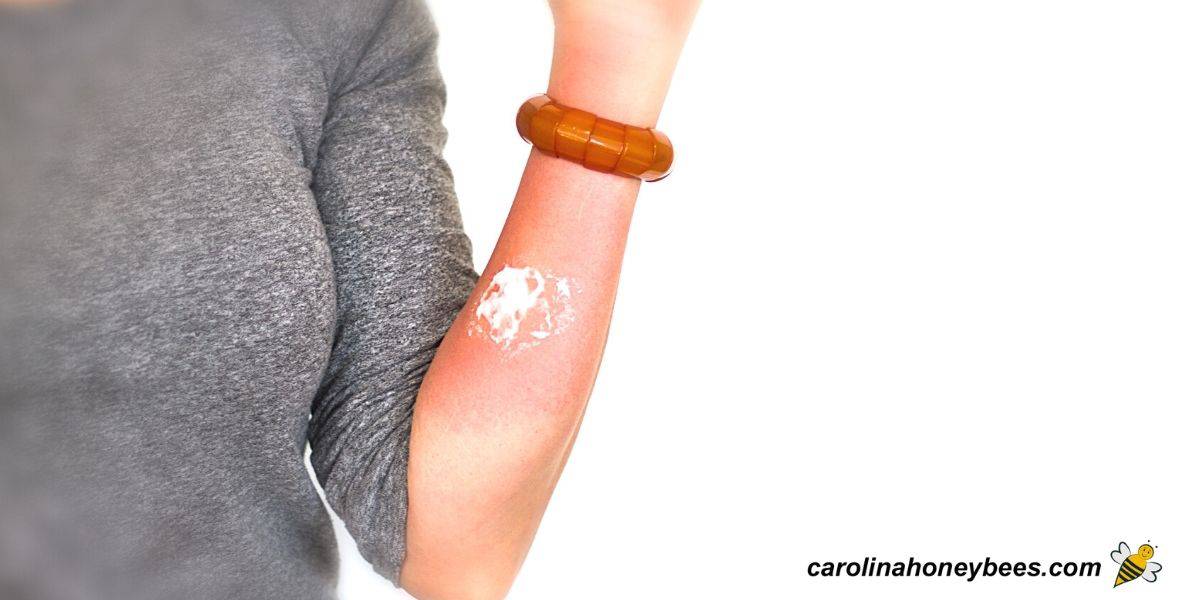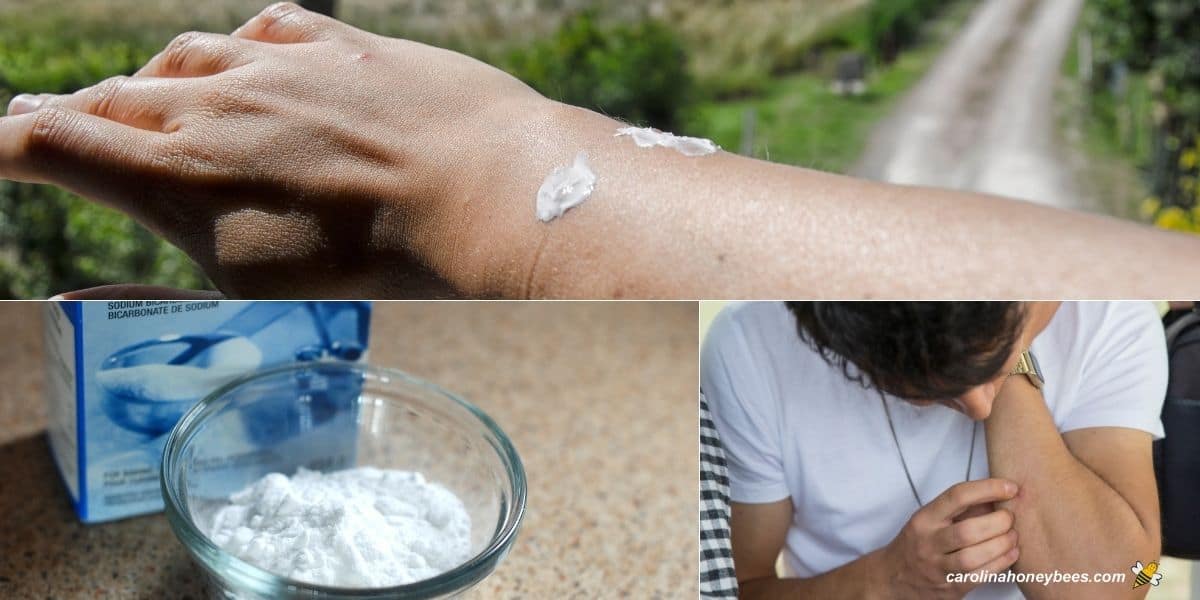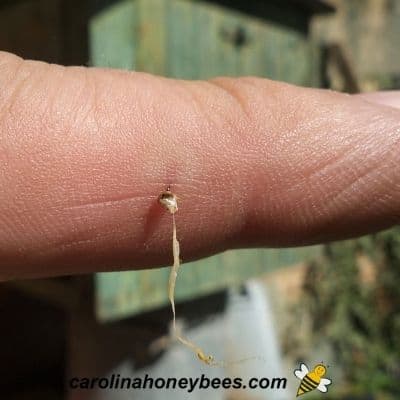Remedies for Bee Stings
If you enjoy spending time outside, you need to know some home remedies for bee stings. Stings are painful- though normally not a serious health threat. Thankfully, most bee sting care can be handled at home. However, when in doubt – always seek professional medical assistance. For those occasions with minor swelling, pain and itching, you may already have something on hand to minimize your discomfort.

Even though they are docile insects, stings from honey bees are common in warm weather. However, honey bees only sting for defense – being aware of your surroundings may help you and the bees stay safe.
Natural Remedies for Bee Stings
If you have a local reaction (this is most common) the following tips may provide some relief. Try to avoid scratching the sting site. ( I know… it’s difficult.)
- for pain: aspirin, acetaminophen or antihistamine orally -if allowed
- apply a cold compress to the sting area for 10 minute intervals
- baking soda: thick past of baking soda and water to sting site
- spread a small amount of honey on the sting: another awesome ways to use honey
- toothpaste: applied to site gives relief for bee stings but not wasp
- meat tenderizer applied to sting site
- Apple Cider Vinegar applied to site for 30 minutes
- wet aspirin applied to sting site
- Lavender Oil mixed with Olive Oil applied to site
- Tea Tree Essential Oil mixed with Olive Oil applied to site
- Witch Hazel applied to the sting site several times a day
- Aloe Vera Gel may soothe the swelling
- Meat Tenderizer – mixed with a little water applied to sting site for 30 minutes
- plantain leaves – chew them up and put the paste on the sting site (then make some DIY Plantain Salve for other minor bites.)

Bee Sting Care
If you think you may be allergic, never attempt self treatment for bee stings – visit the nearest emergency center immediate medical attention. Even when you do not have a life-threatening situation, proper bee sting care should begin right away.
- walk away to a safe place
- remove stinger and clean area
Move Away
Of course, move away from the area where the sting occurred – you may be near a nest. It is always a good idea to identify the type of insect that stung you. Do you know what a honey bee looks like – well enough to identify them?
Know the differences between wasps vs bees. Why does it matter? The biggest reason is that a person can be allergic to one and not another.
However, some people are allergic to both types of venom. And, a very few people are allergic to honey too!
Remove the Bee Stinger
If you are stung by a honey bees – you may see a stinger stuck in your skin. Their barbed stinger usually gets stuck – you may see the attached venom sac too. Honey bees usually die after stinging you so they only get 1 shot.
Wasps (such as Yellow Jackets) have smooth stingers and can sting repeatedly! This is one reason homeowners often create Yellow Jacket traps during mid Summer in an effort to reduce the population.
Do not grab and squeeze the stinger as you may only force more venom into your skin. Instead use a fingernail, credit card or any hard surface to scrape the sting away. The clean the area with warm soapy water.

Symptoms & Reactions
Bee sting reactions vary from one person to another. But, they share a few common points.
- pain
- swelling/redness
- itching
- heat
You may experience pain for a few minutes or a bit longer. And, sometimes insects stings hurt worse than other times. Many of my beekeeping friends swear that stings are more painful in late summer than earlier in the year!
Swelling with redness (a local reaction) is common. This is your immune system’s response to the protein rich venom. You may experience some heat near the sting site but it should dissipate by the next day.
If the only affected area is the sting site, you are probably not “allergic”. Less than 3% of the population is truly allergic. That’s not compensation if you are one of that 3%, right?
When to Seek Emergency Help
Local reactions (swelling, redness, itching) are normal. They resolve themselves as long as no infection occurs.
Severe bee allergy reactions are systemic. Affecting parts of the body away from the sting site, they are life threatening. Difficulty breathing, dizziness, nausea and a drop in blood pressure can occur.
Anaphylaxis – signs of a severe bee sting reaction include: swelling in the face (unless you were stung there), swelling of the lips, tongue or throat. Seek emergency help immediately – do not attempt home remedies in this situation.
Whether you are known to be allergic or not, let someone know you have been stung. This is in case you get into an emergency condition and need help.

Caution for Beekeepers
Beekeepers face a higher risk of being stung than most people. Managing colonies with thousands of stinging insects will result in some stings. That’s just a true bee fact – we must face.
But over time, beekeepers learn hive management methods to reduce stinging situations. Wearing our protective beekeeping suits and wise use of a bee smoker saves bee lives and lessens our chance of bee-magedon.
Beekeepers can become immune or more allergic to stings. For some, this represents less effects from venom over the years.
Other beekeepers have pain and swelling from their stings early in the season and less so later in Summer.
And then, there is the beekeeper who has little reaction to stings for 20 years and then all of a sudden-develops an dangerous bee allergy. You just never know. Getting stung is a part of beekeeping. Its not my favorite part.
More Ideas
Take some action to avoid stinging and biting insects. If you plan to be outdoors, whip up a batch of beeswax bug bite sticks. All natural relief in a handy portable tube.
If you are very interested in using natural oils – be sure to check out this article on the most effective Essential Oils for Bee Sting Relief.
FAQs
Swelling from a bee sting can last a while. But, the swelling and redness should fade over the next 24 to 48 hours. If you find the redness growing in size, it is time to head to the doctor and check for an infection.
Your pets can suffer from bee stings too. In fact, your dog may even eat a bee but it is not necessarily life threatening. Like a sting to a human, proper attention is needed for any allergic reaction.
Kids are subject to an increased risk if they get stung multiple times. Their bodies are smaller and cannot cope with as much venom.
The treatment protocol for children is the same as adults. A sting or two with no allergic reactions can be treated the same as adults. If in doubt, call your doctor or emergency center.
In the case of small children, I try to explain that the bees only wanted to protect their home. It was not a personal vendetta against the child.
Minimizing the drama and staying call is important to avoid having your child develop a true fear of all bees.Some pain, swelling and redness can last for several days after a sting. However, these local reactions should start to fade within a day or two. If the sting isn’t healing check with your doctor.
Honey bees have a barbed stinger that become stuck in mammal skin. You will see the stinger and attached venom sack if it is there. If a bit of the stinger is left inside, it will look like a tiny black thread.
Though some insects can bite too – thankfully honey bees do not have teeth or strong mandibles that are capable of piercing your skin. They don’t need sharp teeth with those stingers.
Final Thoughts
All natural remedies for bee stings work better if you were quick to remove that stinger (in the case of honey bees). Less venom means less reaction and less pain later. While they are usually a minor event, any stinging situation should be approached with caution, care and monitoring.
*** Medical Disclaimer – I am a beekeeper not a doctor. These are suggestions and basic information. Seek medical advise and treatment.

